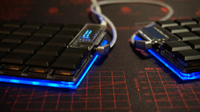The Helix Ortholinear Keyboard Kit: Open Source DNA






The keyboard enthusiast community is vast, opinionated, and remarkably adept at making its dream keyboards into realities. Ortholinear keyboard designs have gained a growing following over the last few years. They quickly became a focal point for innovation and, in some cases, rebellion against design norms. They’re quite unusual when compared with traditional staggered keyboards, which still dominate the consumer market.
The Helix keyboard kit (by Makoto Kurauchi) is based on the “Let’s Split” design from Reddit user /u/wootpatoot, who was inspired by the idea of a split Planck. The Helix is Kaihua PG1350 low profile switch compatible, it supports SMD RGB backlighting or RGB LED underglow, and it can use two OLED screens to indicate keyboard status. It runs on QMK, a community-designed firmware that allows deep customization and multi-layer programmability. It’s also open source, although the creator hasn’t released files for it yet. The Helix looks to be one of the most feature-complete ortholinear kits we’ve covered.
To make a Helix, you’ll need soldering equipment and know-how. You’ll also need to wait--its original group buy closed, and all parts are backordered at the time of this writing. International shipping is also a consideration, as the group buy was based in Japan.
Staggered vs. Ortholinear
Staggered keyboards trace their lineage to manually powered typewriters. A complex system of levers and springs forced designers to use a staggered key layout, as physical conflicts would otherwise prevent operation. When electronic typewriters and keyboards were introduced, the old layout was preserved to ensure user familiarity on the new hardware. Staggered QWERTY has been the norm ever since, even though mechanical limitations no longer apply.
Ortholinear keyboards, which are also called matrix keyboards, place keys in a simple grid pattern. They’re often designed to be smaller than staggered keyboards. A few tricks, like the use of keyboard layers, minimize their footprint. Layers are like an expanded shift key. They assign various functions to keys, which reduces the impact of smaller keyboard layouts. It’s possible to place every key from a 104-key layout into the layers of a tiny keyboard.
Some users swear by ortholinear keyboards, and split variants often advertise further ergonomic gains. Other people don’t adjust well. We recommend trying an ortho before committing to a layout change, if possible. Ergonomics, after all, focus on what is best for you. Trends and marketing won’t increase your comfort levels while typing or gaming.
Kits are all currently out of stock, but when they do come back around, they'll range in cost from $132-175 USD.
Stay on the Cutting Edge
Join the experts who read Tom's Hardware for the inside track on enthusiast PC tech news — and have for over 25 years. We'll send breaking news and in-depth reviews of CPUs, GPUs, AI, maker hardware and more straight to your inbox.
Other ortho options that may pique your interest include the WoodKeys Meira, Contra, and Planck Light.
-
brysonosborne Don't forget the ErgoDox and it's assorted derivatives. They are ortholinear and split, too.Reply -
brysonosborne Don't forget the ErgoDox and it's assorted derivatives. It's ortholinear and split like this one.Reply -
markus.kohler Iris: https://www.reddit.com/r/MechanicalKeyboards/comments/86k39x/testing_typewriter_keyscaps_on_my_iris/Reply
Most Popular




